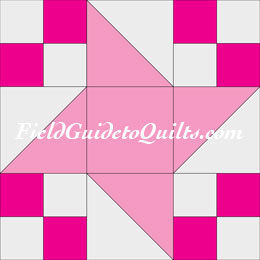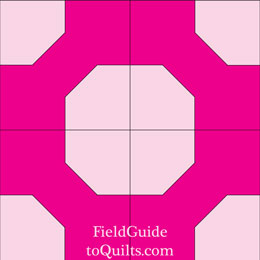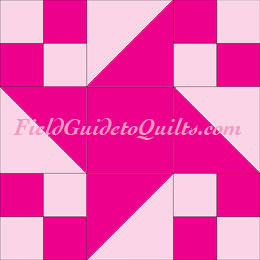| FieldGuidetoQuilts.com |
 Faux Wheels
*** Faux Wheels
***
|
Click on an icon to go directly to the block you're interested in.
 Chinese Coin
Chinese Coin  Squirrel in a Cage
Squirrel in a Cage Rolling Stone
Rolling Stone Johnnie Round the CornerLAC
Johnnie Round the CornerLAC Johnnie Round the Corner Hall
Johnnie Round the Corner Hall Kitty Corner
Kitty CornerComing soon:
 Magic Circle
Magic CircleFriendly Hand
















Friendly Hand
 Friendly Hand
Friendly HandComfort, 1920 Indiana Puzzle/Monkey Wrench/Chinese Coin/Indian Puzzle
Friendly Hand first appeared in Comfort magazine in 1920, and the Kansas City Star printed it as Indiana Puzzle in 1930.
Put them together and you'll have a quilt with alternating colors. Bear in mind, though, that you'll want to user less than a full block at the top and right edge of the quilt to avoid the candy-cane effect you see in our mockup. Or you can recreate the candy-cane effect on the other two sides if you like it.
The other names listed above are from Aunt Martha booklets, while Monkey Wrench was also in a Mrs. Danner booklet in 1934. Our source is Brackman's Encyclopedia.
Several other blocks just below this one are similar but fall short of a curvy look when they're in a group.
Square & Half Square
















Square & Half Square
The Kansas City Star came up with this pattern in 1934.
It was a design, the Star said, that "Little girls of colonial days frequently pieced, as it was simple and pretty in colors." We have no idea why the Star thought so, but there you have it.
It's interesting to us that a graceful-looking block like Friendly Hand, with one simple color change, looks so very different. To us, this block looks like a guy with a tray slipping on a wet floor.
See what we mean?
 Oh well, never mind.
Oh well, never mind. The name Swastika was in an issue of the Household Journal, per Brackman.
Water Wheel
















Water Wheel (Cabot) This block is from Nancy Cabot of the Chicago Tribune (1936). Nancy Cabot was the pen name of Elizabeth Leitner Rising.
Cabot's block designs were published daily in the Tribune for five solid years, and then less often until about 1945. In all, Jinny Beyer tells us, more than 2,000 blocks are credited to her.
Quite often, Cabot's blocks are similar to blocks already in print, but Cabot put her own spin on most of them, such as flipping the block and adding a third color. We think that's what she did with Square & Half Square to create Water Wheel.
Water Wheel
















Water Wheel (Farm Journal)
Chinese Coin















 Chinese Coin as pictured
Chinese Coin as pictured
 Chinese Coin using offset squares
Chinese Coin using offset squares
Most quilters would treat the block as if the block was an offset square, which creates a simple windowpane. We've shown a mockup. If a newbie used the block as is, there would be gigantic four-piece squares everywhere, as you can see in our next mockup.
We've also included a setting using alternate-color sashing. It's a handy way to bring variety to a quilt top.















 Chinese Coin using a magical quilter trick
Chinese Coin using a magical quilter trick
Squirrel in a Cage















 Squirrel in a Cage
Squirrel in a Cage Squirrel in a Cage
Squirrel in a CageKCS, 1935
 This block, as well as Rolling Stone and Johnnie Round the Corner below, can be made with the instructions for a block that quilterscache.com calls Broken Wheel. Click on the Make it! icon to go there.
This block, as well as Rolling Stone and Johnnie Round the Corner below, can be made with the instructions for a block that quilterscache.com calls Broken Wheel. Click on the Make it! icon to go there. Johnnie Round the Corner
















Johnnie Round the Corner
 Johnnie Round the Corner
Johnnie Round the Corner Hall, 1935 Single Wedding Ring
Hall's variation of Squirrel in a Cage adds a third color to create a livelier block. Havig called it Single Wedding Ring in her book Carrie Hall Blocks.
Rolling Stone
 Rolling Stone
Rolling StoneLAC, #216
1897
















Johnnie Around the Corner
You have to look twice to see it, but the block layout is exactly the same.
Johnnie Around the Corner
















Johnnie Around the Corner
 Johnnie Around the Corner
Johnnie Around the CornerLAC, #376
1897

That takes us to the LAC's Johnnie Around the Corner (#376), which is different from any of the other three we've just discussed. All three of those use a single block design, the one covered as Broken Wheel on Marcia Hohn's Quilter's Cache web site. That one is on a 6x6 grid, and quilters call it a nine-patch.
The Ladies Art Company's Johnnie Around the Corner ("Johnnie ar'd the Corner" to be precise) is on an 8x8 grid, and it's described as a four-patch.
That's the one you'll see if you click on the "Make It" icon at right. It links to Hohn's instructions for Johnny Round the Corner.
We think it's spelled that way to keep on our toes.
Kitty Corner















 Kitty Corner
Kitty Corner  Kitty Corner
Kitty Corner>Finley, 1929
Magic Circle















 Magic Circle
Magic Circle  Magic Circle
Magic CircleHang in there and we'll tell you more.




